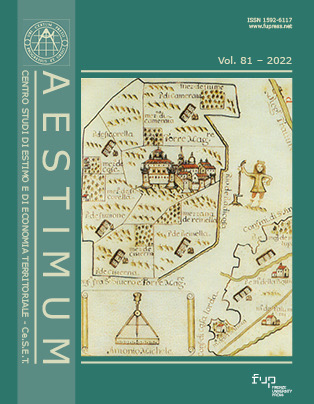Published 2023-02-13
Keywords
- Home Price,
- Prediction,
- Support Vector Regression,
- Artificial Neural Networks,
- Multiple Linear Regression
Abstract
In the literature, there are two basic approaches regarding the determination of house prices. One of them is the prediction of house price using macroeconomic variables in the country where the house is produced, and another one is the price prediction models, which we can express as micro-variables, by considering the features of the house. In this study, the price of the house was attempted to be predicted using machine learning methods by establishing a model with micro variables that reveal the features of the house. The study was conducted in Turkey’ Antalya province, where household housing demand of foreigners is also high. The house advertisements in locations belonging to the lower, middle- and upper-income groups were selected as the sample. In the results, it was observed that the artificial neural network (ANN) method made predictions with more meaningful results compared to support vector regression (SVR) and multiple linear regression (MLR). These results appear to be a viable model for institutions that supply housing, mediate housing sales, and provide housing financing and valuation. It is considered that this model, which can be used to predict fluctuating house prices, especially in developing countries, will regulate the housing market.
References
Alpar, R. (2003) Uygulamalı Çok Değişkenli İstatistiksel Yöntemlere Giriş 1. 2.Baskı, Nobel Basımevi, Ankara
Bahçecitapar, M., & Aktaş, S. (2017). Çoklu doğrusal bağlantı durumunda doğrusal karma modelin kullanımı ve bir uygulama. Sakarya University Journal of Science, 21(6), 1349-1359.
Bircan, H. (2004). Çoklu doğrusal regresyonanalizi: Tıp verileri üzerine bir uygulama. Kocaeli Üniversitesi Sosyal Bilimler Dergisi, (8), 185-208.
Cechin, A., Antonio, S. and Gonzales, M. A. 2000. Real Estate Value at Porto Alegre City Using Artificial Neural Networks. Neural Networks, Proceedings, Sixth Brazilian Symposium on IEEE, November 2000. 237-242.
Çakır Zeytinoğlu, F. (2007) İşletmelerin Dönen Varlıklarının Satışlar Üzerindeki Etkileri: En İyi Regresyon Denkleminin Seçimi ve Sektörel Karşılaştırma. Marmara Üniversitesi İ.İ.B.F. Dergisi, 23(2), 331-349.
Çoban, F., & Demir, L. (2021). Yapay Sinir Ağları ve Destek Vektör Regresyonu ile Talep Tahmini: Gıda İşletmesinde Bir Uygulama. Dokuz Eylül Üniversitesi Mühendislik Fakültesi Fen ve Mühendislik Dergisi, 23(67), 327-338.
Demir L., Akkaş S. 2018. A comparison of sales forecasting methods for a feed company: A case study, Pamukkale University Journal of Engineering Sciences, Cilt. 24(4), s. 705-712.
Drucker, H., Burges, C.J. C., Kaufman, L., Smola, A., Vapnik, V. 1997. Support vector regression machines, Advances in Neural Information Processing Systems, Cilt. 9, s. 155-161.
Esperanza, M. and Gallego, J. 2004. Artificial Intelligence Applied to Real Estate Valuation an Example fort he Appraisal of Madrid. Catastro. April 2004. 255-265.
Feggella, D. (2019, February 19). What is machine learning? emeRJ. https://emerj.com/ai-glossaryterms/what-is-machine-learning/
Lacoviello, M. (2000). House Prices and The Macroeconomy in Europe: Results from a Structural VAR Analysis. European Central Bank. Working Paper No:18
Kayaalp, G.T., Güney, m. Ç., & Cebeci, Z. (2015). Çoklu doğrusal regresyon modelinde değişken seçiminin zootekniye uygulanışı. Çukurova Üniversitesi Ziraat Fakültesi Dergisi, 30(1), 1-8.
Kim, K. ve Park, J. (2005). Segmentation of the housing market and its determinants: Seoul and its neighbouring new towns in Korea, Australian Geographer, 36(2), 221-232.
Koktashev, V., Makee, V., Shchepin, E., Peresunko, P., & Tynchenko, V. V. (2019). Pricing modeling in the housing market with urban infrastructure effect. Journal of Physics. Conference Series, 1353(12139), 1–6
Ngiam, K. Y., & Khor, I. W. (2019). Big data and machine learning algorithms for health-care delivery. The Lancet Oncology, 20(5), 262–273
Nihar Bhagat, Ankit Mohokar, Shreyash Mane "House Price Forecasting using Data Mining" International Journal of Computer Applications,2016.
Park, B. H., & Bae, J. K. (2015). Using machine learning algorithms for housing price prediction: The case of Fairfax County, Virginia housing data. Expert Systems with Applications, 42(6), 2928–2934.
Shiller, R. J. (2007). Understanding recent trends in house prices and home ownership. National Bureau of Economic Research, Working Paper 13553.
Thamarai, M., & Malarvizhi, S. P. (2020). House Price Prediction Modeling Using Machine Learning. International Journal of Information Engineering & Electronic Business, 12(2).
Vapnik, V. 1995. The Nature of Statistical Learning Theory. Springer, New York, 314s.
Varma, A., Sarma, A., Doshi, S., & Nair, R. (2018, April). House price prediction using machine learning and neural networks. In 2018 second international conference on inventive communication and computational technologies (ICICCT) (pp. 1936-1939). IEEE.
Yamane, T., Statistics: An Introductory Analysis, New York: Harper&Row, 1969.
Yu, H., and J. Wu. (2016). “Real estate price prediction with regression and classification CS 229 Autumn 2016 Project Final Report 1–5."







